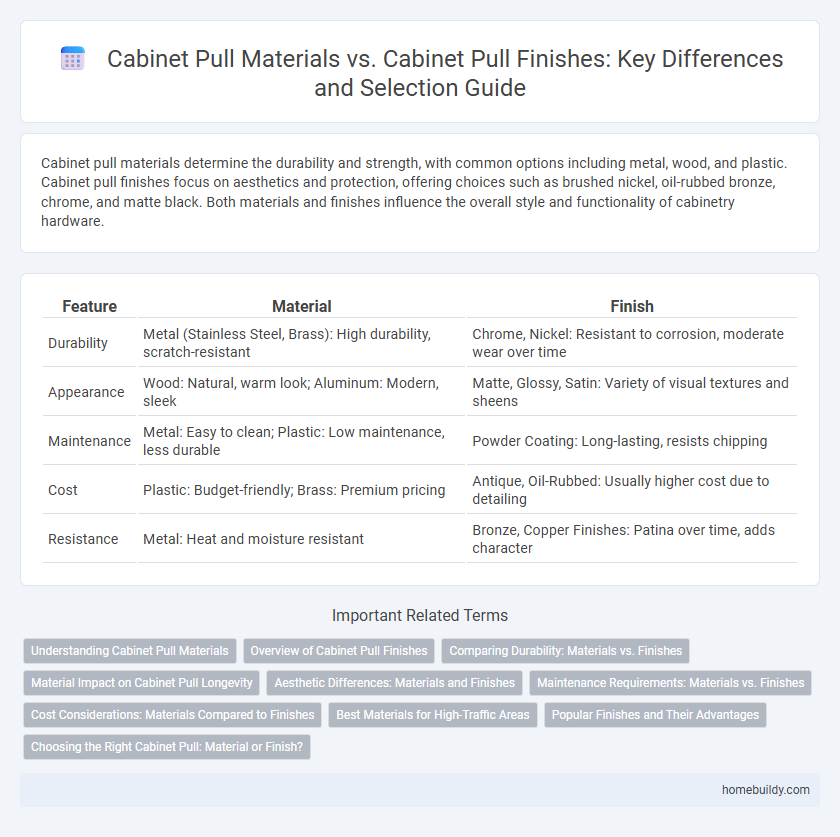Cabinet pull materials determine the durability and strength, with common options including metal, wood, and plastic. Cabinet pull finishes focus on aesthetics and protection, offering choices such as brushed nickel, oil-rubbed bronze, chrome, and matte black. Both materials and finishes influence the overall style and functionality of cabinetry hardware.
Table of Comparison
| Feature | Material | Finish |
|---|---|---|
| Durability | Metal (Stainless Steel, Brass): High durability, scratch-resistant | Chrome, Nickel: Resistant to corrosion, moderate wear over time |
| Appearance | Wood: Natural, warm look; Aluminum: Modern, sleek | Matte, Glossy, Satin: Variety of visual textures and sheens |
| Maintenance | Metal: Easy to clean; Plastic: Low maintenance, less durable | Powder Coating: Long-lasting, resists chipping |
| Cost | Plastic: Budget-friendly; Brass: Premium pricing | Antique, Oil-Rubbed: Usually higher cost due to detailing |
| Resistance | Metal: Heat and moisture resistant | Bronze, Copper Finishes: Patina over time, adds character |
Understanding Cabinet Pull Materials
Cabinet pull materials directly impact durability, weight, and maintenance requirements, with common options including stainless steel, brass, zinc alloy, and aluminum. Stainless steel offers corrosion resistance ideal for kitchens, while brass provides a classic look but may require more upkeep. Choosing the right material enhances both functionality and aesthetic longevity, separate from the cabinet pull finish which mainly affects visual style.
Overview of Cabinet Pull Finishes
Cabinet pull finishes determine the aesthetic and durability of hardware, with common options including matte black, brushed nickel, oil-rubbed bronze, and polished chrome. Each finish not only complements different interior styles but also affects resistance to tarnishing, corrosion, and fingerprints. Selecting the right finish enhances both functionality and the overall design cohesion of cabinetry in kitchens and bathrooms.
Comparing Durability: Materials vs. Finishes
Cabinet pull materials like stainless steel, brass, and zinc alloy offer inherent durability that directly impacts lifespan and resistance to wear, corrosion, and impact. Finishes such as brushed nickel, oil-rubbed bronze, or chrome provide a protective and aesthetic layer but tend to wear off or chip over time, requiring maintenance or refinishing to preserve appearance. Comparing durability, material composition primarily determines structural strength and longevity, while finishes influence surface resilience and visual appeal under everyday use.
Material Impact on Cabinet Pull Longevity
Cabinet pull materials such as stainless steel, brass, and zinc alloy directly influence their durability and resistance to corrosion, wear, and daily use. High-quality metals like stainless steel offer superior longevity by withstanding moisture and frequent handling without tarnishing or degrading. Finishes, while important for aesthetic appeal, mainly serve as a protective layer and can wear off over time, but the underlying material determines the overall lifespan of the cabinet pull.
Aesthetic Differences: Materials and Finishes
Cabinet pulls crafted from brushed nickel offer a sleek, modern aesthetic, contrasting with the rustic warmth conveyed by oil-rubbed bronze finishes. Materials like stainless steel emphasize durability and a contemporary look, while antique brass finishes provide a vintage charm that enhances traditional cabinetry styles. The interplay between material texture and finish color significantly influences the overall visual appeal and perceived quality of cabinetry hardware.
Maintenance Requirements: Materials vs. Finishes
Cabinet pulls made from solid materials like stainless steel, brass, or zinc alloy offer inherent durability and corrosion resistance, requiring minimal maintenance to keep their structural integrity. Finishes such as matte, brushed, or plated coatings demand regular cleaning and occasional polishing to preserve their appearance and prevent wear or tarnish over time. Choosing materials with natural resilience reduces upkeep complexity, while specific finishes may need tailored care routines to maintain aesthetic quality and extend lifespan.
Cost Considerations: Materials Compared to Finishes
Cabinet pulls made from materials like stainless steel, brass, and zinc alloy generally have higher upfront costs due to raw material expenses and manufacturing processes, while finishes such as chrome, matte black, or brushed nickel add variable costs primarily influenced by plating or coating techniques. Material choice impacts durability and weight, affecting long-term value, whereas finishes provide aesthetic appeal and surface protection at a comparatively lower price increment. Budget-conscious decisions balance the initial investment in quality materials with the cost-effective enhancement offered by diverse finish options.
Best Materials for High-Traffic Areas
Durable materials such as stainless steel, brass, and zinc alloy excel for cabinet pulls in high-traffic areas due to their resistance to wear and corrosion. Metal finishes like brushed nickel or matte black also offer longevity while hiding fingerprints and scratches, enhancing both aesthetics and functionality. Selecting robust materials paired with resilient finishes ensures cabinet pulls maintain their appearance and performance in frequently used spaces.
Popular Finishes and Their Advantages
Popular cabinet pull finishes include brushed nickel, oil-rubbed bronze, and matte black, each offering unique aesthetic and functional benefits. Brushed nickel provides a sleek, modern look with excellent resistance to fingerprints and tarnishing, making it ideal for busy kitchens. Oil-rubbed bronze offers a warm, vintage appeal and excellent durability, while matte black adds a bold, contemporary touch that hides smudges and wear effectively.
Choosing the Right Cabinet Pull: Material or Finish?
Choosing the right cabinet pull involves balancing material durability and finish aesthetics to ensure long-lasting performance and style. Metal materials such as stainless steel and brass offer strength and corrosion resistance, while finishes like brushed nickel and oil-rubbed bronze provide diverse visual appeal and protection against wear. Prioritizing material for functional durability while selecting finishes to complement kitchen design creates a harmonious and practical cabinetry upgrade.
cabinet pull materials vs cabinet pull finishes Infographic

 homebuildy.com
homebuildy.com